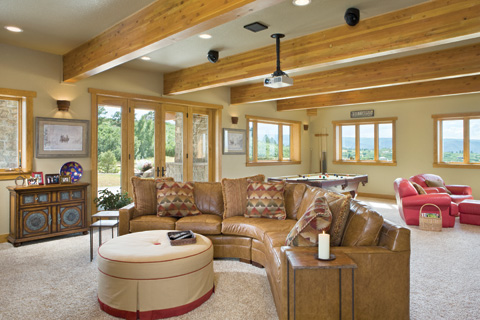Log homes have come a long way from the days of Little House on the Prairie and Grizzly Adams. Modest one- and two-room cabins have given way to multilevel showstoppers that are equal parts art and architecture. Still, the yearning to invest sweat equity remains strong for some log home owners. There is romanticism to knowing you built your home with your own two hands.
At the advent of the modern log home industry in the 1960s and 1970s, building your own log home was quite common. Designs were simple and, for the most part, small, so your average do-it-yourselfers could take on building a log cabin as long as they had reasonable skills. “This phenomenon of the DIY log home was born into the log home industry in the late 1960s when they tried to harken back to the days of pioneers,” says Robert Lockerby of Summit Log and Timber Homes in Boise, Idaho. “They kept the design really simple then, but the log home industry is a totally different game now.” Fast forward to today and the DIY model is more the exception than the rule. Why the change? Three big reasons: experience, time, and money.
The log & timber home market has evolved as log home companies have designed homes that are bigger and more sophisticated than they once were, requiring the know-how of an experienced builder. Technology is a consideration as well—more and more homeowners are opting for smart technology that simplifies life but makes construction complex. A DIY project can also take longer, especially if you don’t live near your building site. Finally, financing plays a part. Though you may opt to build your own home to save on construction, banks are often hesitant to approve loans to projects that don’t have a licensed contractor in the mix.
Con: Experience Required
Complex new home designs require an experienced contractor. “In the past the log home market was more of a do-it-yourself market, when homes had a simple design and were simple to build,” says Joe Folker, principal at Timberhaven Log & Timber Homes in Middleburg, Pennsylvania. “It blossomed from there, and with that complexity you need someone who is skilled.”
If you’re thinking about building your own log home, consider your skills and experience. If you have a background in the building trades, you might very well be able to take on building your own home. On the other hand, if you are handy with a hammer but have never built anything on your own, you might be biting off more than you can chew.
Pro: Add Your Talents
Consider instead taking on specific limited aspects of the project, like interior painting, landscaping, or finishing a rec room. “Channel your energy into what you are capable of doing and what you enjoy doing,” advises Folker, adding that you should talk to your contractor about how you can best contribute to the project. For one person that may mean taking over construction of outdoor living areas, for another that might mean working hand in hand with an electrician on implementing smart home technology.
Lockerby concurs. “You can be involved in all aspects of the design of the home—placement on the lot, how the driveway will come in, how the house will be situated for the views, and picking out colors and textures for the interior,” he says. It’s possible to put your personal stamp on your home without ever picking up a hammer, and quality log home professionals know that homeowner involvement on these decisions is the key to ending up with a happy customer.

Prykhodov
Con: Construction Takes Time
If you want your home project completed in a timely fashion, DIY is likely not the best route for you. Preparing the building site, applying for permits, lining up subcontractors—all of these elements take time before you’ve stacked a single log or raised a single timber. And if you are working full time and trying to build on the weekends, you’re looking at years of construction ahead.
“A six-month or year-long project turns into three or four years, and you can imagine the condition of the materials at that point,” says Folker. In addition, your lender will want the construction completed on time.
Pro: Part of the Process
If time is not a primary concern, especially if you are self-funding the project, you may enjoy the process no matter how long it takes. Working directly with subcontractors at each step may bring you satisfaction, and you have more opportunities to ensure that every facet of construction meets your criteria. If you have an appreciation for the journey along the way, a DIY project may be fulfilling.
Con: False Economy?
We all know the old saying, “Don’t trip over a dollar to pick up a dime!” It’s a caution that is well applied to home construction. Many people consider going the DIY route in an effort to save money. By serving as their own general contractor, they figure, they can save 10 to 15% of the project cost.
That may be true, but there are savings to be had by employing a general contractor. “A good general contractor can buy lumber and other materials for a discount, which can offset the cost,” says Lockerby. “Your general contractor knows the subcontractors in the area—those who do good work and those who don’t.” That expertise can save you time and money.
“A contractor is generally going to charge 10 to 15%—but you can save some of that on the project because there are so many efficiencies through using a contractor,” says Folker. “Contractors have their own tools, equipment, and skilled employees. There’s quite a bit of money you’d have to put up front to invest in all that before you have even started.”
Before you take the leap, consider your previous building experience, your home’s design complexity, your available time, and your source of funding. Even if you have the time and experience a DIY project requires, at the end of the day, it may not be an option if you can’t convince the bank that you are qualified for the job.

